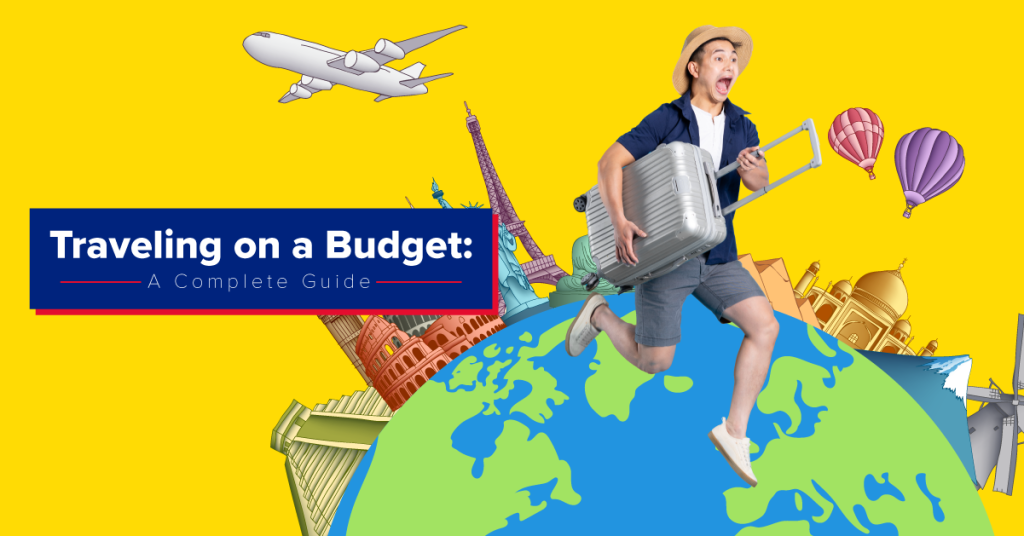Traveling is a fun way to break the monotony of daily life. It lets you see your dream destinations, meet new people, try different cuisines, and learn about other cultures.
However, one can’t help but think that traveling is expensive. This misconception may keep you from exploring new places and widening your worldviews.
The truth is you don’t need a lot of money to travel. You can plan and enjoy an exciting trip if you set a budget, be flexible, and research. Who knows? Traveling on a budget may even be more rewarding as it encourages you to step out of your comfort zone and try new things.
If you want to take a memorable trip without spending a fortune, check the infographic below to learn how to plan a trip on a budget.

How to Plan Your Trip
Planning a trip on a budget can be overwhelming, especially if you don’t know where to start. Below are some tips to help you get started.
1. Start planning early
Whether traveling domestically or internationally, you should plan your trip as early as possible by setting a budget, building a vacation fund, and plotting an itinerary. Early planning helps you secure better deals on flights, accommodations, rentals, and activities since prices tend to increase as your travel date approaches.
Plus, you can make changes or adjustments to your itinerary without the risk of losing your reservation or paying extra fees. This point is crucial if you’re traveling on a budget.
2. Choose an affordable destination
As exciting as it is to visit any place you want, some destinations may be more expensive than others. For instance, countries like the United States, Japan, and South Korea require visas, which entail a lot of time and money. However, you can opt for domestic trips to keep your expenses low.
In the Philippines, you can go to dreamy destinations like Boracay, Palawan, Batanes, Siargao, and Bacolod. Alternatively, traveling to visa-free countries is a great option if you want to leave the country. You can visit Cambodia, Hong Kong, Taiwan, Thailand, or Vietnam in Asia. In South America, you can go to Bolivia, Colombia, Costa Rica, or Peru.
3. Look for deals
Travel deals can help you enjoy the same experiences and activities as other travelers but at a more affordable price. For instance, some airlines offer low-cost flights to popular destinations, especially during off-peak seasons. Many travel agencies also give discounted tour packages if you travel with friends or family.
You can check your credit card provider’s rewards and travel promos, such as discounted flights and hotel rates, no-expiry miles, free travel insurance, and rebates. Use these perks to make the most of your trip without overspending.
4. Schedule your trips during off-seasons
Some destinations have peak periods that cause prices to inflate and attract thousands of tourists. As such, travel during off seasons to save money and avoid huge crowds. If you want to visit a local beach, consider traveling between December and February, as the weather isn’t too hot.
5. Book midweek flights
Domestic flights that depart on Monday, Tuesday, or Wednesday are 12% cheaper than weekend departures. Flight prices also tend to increase during the weekends as leisure travelers typically fly on or before weekends, creating a higher demand for Thursday and Friday flights. Consequently, flying out on a Friday and returning on a Sunday is more expensive.
On the contrary, booking your trip midweek gives you savings on airfare.
6. Pick the right time to book
Look out for sales or promos on flights and tours to secure discounted rates. Sign up for an airline’s or travel agency’s email newsletter and follow them on social media to stay informed about their exclusive deals and promos.
You can also use price comparison websites and apps to compare prices for flights and tours across different providers. Enable their price alerts to know when a particular flight or tour price drops.
7. Go for alternative accommodations
Instead of booking a hotel, opt for an Airbnb, guest house, vacation rental, or hostel for your trip. Most of them come with kitchens and laundry areas. Hostels even allow you to room with fellow travelers, which is a great way to meet new people during your trip.
Meanwhile, Airbnb properties are 33% cheaper for big groups than hotels, which is great if your friends or family are tagging along. A stay for several nights also slashes the rates by 32%.
When choosing an alternative accommodation, remember to consider transportation routes, staff availability, food, amenities, and overhead fees to know how much you’ll spend throughout your stay.
8. Create an itinerary
Plotting your travel itinerary will help you better understand how much to save for your trip. Your first step is to list everything you want to do, such as visiting museums and cultural sites, attending events, or eating in particular restaurants. Map your stops to see how many places you can visit and how much you’ll likely spend in a day.
Lastly, organize your travel information, such as your check-in times, confirmation numbers, and other reservations, to keep track of your schedule and budget. Leave some room for travel delays that may cause you to pay overhead fees.
How to Budget for Your Trip
Budgeting for a trip goes beyond saving money for travel expenses. It involves careful planning and consideration of all the costs associated with traveling, such as transportation, accommodations, food, activities, and unexpected charges. Here are some ways to budget for your trip.
1. Identify your biggest expenses first
For major expenses—airfare, accommodations, transportation, food, and activities—it’s best to research how much they cost in your destination and allocate a realistic amount for each category. The goal is to prioritize your expenses and stay within your budget.
2. Account for smaller expenses
Add smaller expenses like souvenirs, snacks, phone coverage, public transportation fares, and tips with the larger expenses to estimate their combined costs and see if your budget is feasible. If not, consider cutting back on some expenses or giving yourself more time to save before scheduling a trip.
3. Compare prices
You can always find affordable accommodations, meals, and activities wherever you go. So, compare all prices related to your trip to save money.
For instance, research places serving affordable meals in the city or town you’ll visit. You don’t need to eat in a fancy restaurant to enjoy the area’s local cuisine. Sometimes, hole-in-the-wall establishments serve equally good food at lower prices.
You can also take public transportation instead of taxis or private cars when getting around places. Then, check specific sites in your itinerary for directions. Some of them might be within walking distance from your accommodation.
4. Set aside funds for emergencies
Anything can happen during a vacation, including accidents, medical emergencies, lost or stolen belongings, and other unexpected expenses. As such, set aside some money for these emergencies.
Ensure you have enough cash for a return ticket, hotel, food, and medical expenses. If your budget allows, get travel and medical insurance to reimburse your losses or unexpected expenses.
5. Start saving early
Once you’ve finalized your itinerary and travel budget, save for your trip as soon as possible. Use money management apps to track your progress and know which daily expenses you can reduce to hit your vacation savings goals. You can also set automatic transfers using mobile banking apps for consistent results.
How to Recover Your Budget After a Vacation
The hard part about taking a vacation is ending it. You inevitably need to return to your everyday life, review your expenses, and evaluate your next steps.
Don’t fret; you can recover your finances and get back on track in multiple ways. Below are some practical tips for regaining control over your budget.
1. Review your financial state post-vacation
Assess your travel expenses and reflect on what worked well and what didn’t to help you strategize for the future. If you went over budget, try to identify the cause. Was it due to an expense you failed to include in your budget? Knowing the problem area can help you create a more effective budget plan in the future.
Ultimately, it would help to realize that going over the budget is normal. You were on vacation and needed funds to enjoy your trip. Give yourself a break and charge your mistakes to experience.
2. Adjust your budget
You may need to reallocate funds and alter your goals to rebuild your budget. For instance, it might be practical to pause saving for retirement to rebuild your emergency fund. You may also need to stop dining out or availing of payday sales while repaying your credit card travel-related bills.
3. Cut back on unnecessary spending
Recategorize your essential and non-essential expenses and set your priorities straight. Obviously, spending only on more important things like food, utilities, and rent would be best.
The key is knowing how to say “no” to less essential expenses. Your future self will thank you for the sacrifices you make today.
Take the Vacation You Deserve
Traveling on a budget doesn’t mean compromising quality trips or missing out on exciting experiences. You can still have an amazing vacation if you plan, look for travel deals, and make smart financial choices. Use the tips above to learn how to plan your trip on a budget and empower yourself for more adventures.
If you need financial assistance to make your travel dreams a reality, consider applying for an online loan with low interest at Asialink Finance Corporation. Our flexible loan options and competitive rates can help you finance your next trip and make unforgettable memories. Don’t let money hold you back from traveling. Apply for a loan at Asialink today!
- Truck Maintenance Checklist: 14 Ways to Keep Your Truck in Top Shape - December 20, 2023
- How to Stop Emotional Spending: Exploring 7 Common Triggers - November 9, 2023
- How to Build an Emergency Fund: 6 Steps to Budgeting for Unforeseen Expenses - October 31, 2023






